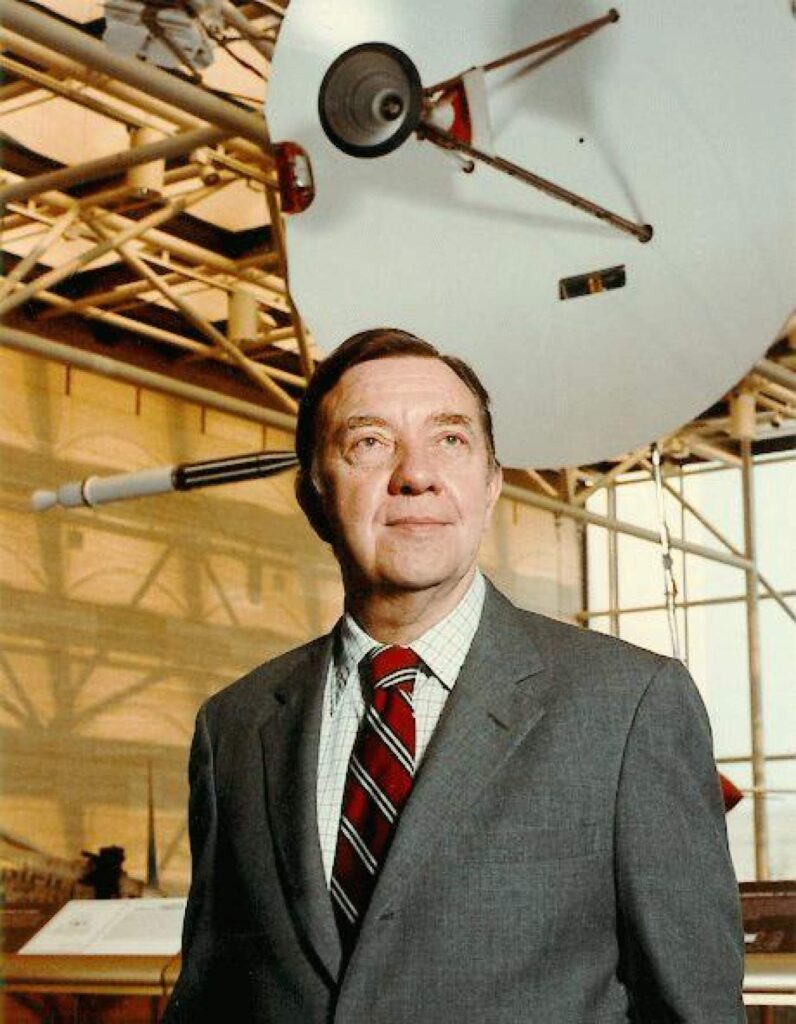James A. Van Allen was born in Mount Pleasant, Iowa on September 7, 1914. He was valedictorian of his Mount Pleasant Public High School class in 1931 and graduated from Iowa Wesleyan College in 1935. He enrolled in the University of Iowa where he received a Master of Science degree in Physics in 1936 and a Ph.D. in Nuclear Physics in 1939. In 1940, Van Allen accepted employment with the Department of Terrestrial Magnetism at the Carnegie Institute in Washington, where he studied photodisintegration. With the approach of World War II, he was assigned to develop photoelectric and radio proximity fuses for bombs, rockets, and gun-fired projectiles.
In April 1942, James Van Allen began working at the Applied Physics Laboratory at Johns Hopkins University, helping to develop a rugged vacuum tube. He also assisted in the invention of proximity fuses for weapons, especially for anti-aircraft projectiles used by the U.S. Navy. By the fall of 1942, he had been commissioned as an officer in the Navy and was sent to the Pacific Theater to field test and complete operational requirements for the proximity fuses.
Dr. Van Allen became a pioneer in space exploration after World War II. His near-Earth and high-altitude research, and his work with V-2 rockets and their developer Wernher von Braun was an important part of the formation of America’s Space Program. Van Allen was head of the Department of Physics and Astronomy at the University of Iowa from 1951, until his retirement in 1985. In that position he collaborated with the Carnegie Institution, the Applied Physics Laboratory, John Hopkins University, the Jet Propulsion Laboratory, and NASA. During his career, he authored 246 research papers on a variety of subjects from cosmic rays to solar energetic particles.
James Van Allen’s most significant accomplishments began in 1955 when he helped develop several proposed experiments for a scientific satellite as part of the U.S. effort for the International Geophysical Year of 1957-1958. His proposal for an American satellite was ignored until the Soviet Union’s launch of Sputnik, mankind’s first satellite in October 1957. Van Allen’s Explorer spacecraft was then quickly approved for launch on one of von Braun’s Redstone rockets.
Explorer I, the first U.S. satellite, was launched on January 31, 1958, and reached an apogee of 1,553 miles, deep inside the radiation belts that encircle the Earth. The satellite carried a radiation detector provided by Dr. Van Allen’s University of Iowa team. Explorer I returned enormously important scientific data about the radiation belts that now bear Van Allen’s name. Named to the National Academy of Sciences in 1959, he became a worldwide celebrity and one of the most sought-after scientific advisers, working with the highest levels of government and scientific administration.
A member of the National Academy of Sciences’ Space Science Board since its inception in 1958, and working with NASA since its creation in 1959, Dr. Van Allen helped plan and select the initial suite of space-based observations and experiments. In 1962, he was Principal Investigator on NASA’s Mariner 2 probe to Venus, the first successful mission to another planet. James Van Allen remained among the world’s most influential of scientists throughout the 1960s, laying the groundwork for the exploration of the outer solar system by 23 other robotic probes, including Pioneer 10 and 11, Voyager, and Galileo. James Van Allen was an articulate and outspoken advocate of small, inexpensive missions long before this view became popular.
In 1987, President Ronald Reagan presented Dr. Van Allen with the National Medal of Science, the nation’s highest honor for scientific achievement. In 1989, Van Allen received the Crafoord Prize, awarded by the Royal Swedish Academy of Sciences in Stockholm for scientific research in areas not recognized by the Nobel Prizes. Dr. Van Allen was also was a consultant to the U.S. Congress Office of Technology Assessment, NASA, and the Space Studies Board of the National Academy of Sciences.
Dr. James Van Allen died in Iowa City on August 9, 2006, at the age of ninety-one.

